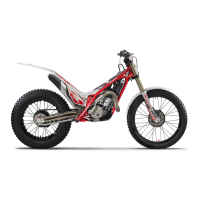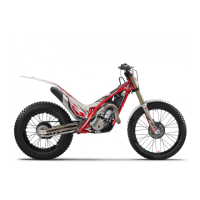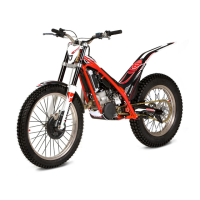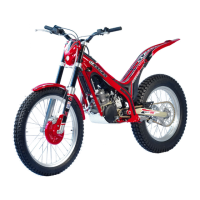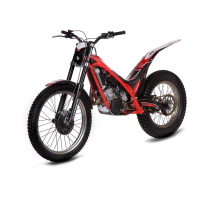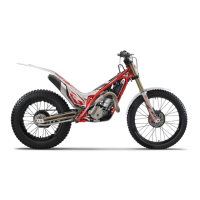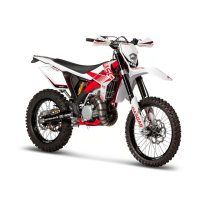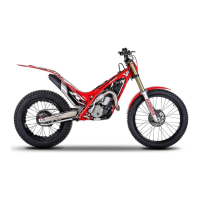Do you have a question about the GAS GAS TXT PRO 2012 and is the answer not in the manual?
Explains the meaning of warning symbols used in the manual for user safety and vehicle protection.
Details the duration and conditions for warranty coverage of the motorcycle.
Outlines the responsibilities of the owner to maintain warranty validity.
Lists components and conditions not covered by the manufacturer's warranty.
Details engine displacement, bore/stroke, lubrication, ignition, and transmission gear ratios.
Covers frame type, suspension details, brake system types, and disc diameters.
Provides overall height, width, seat height, ground clearance, and fuel tank capacity.
Instructions on how to engage and disengage the steering lock system.
Specifies the fuel tank capacity and recommended gasoline octane rating.
Explains the functions of the fuel tap (reserve, open, closed).
Describes the choke's role in aiding cold engine starting.
Details the required free play for the clutch lever for optimal operation.
Specifies the ideal position and free play for the front brake lever.
Step-by-step guide to checking the engine oil level using the sight window.
Instructions for draining and refilling the engine crankcase oil.
Step-by-step guide for safely removing the motorcycle's fuel tank.
Specifies the type of cooling fluid to use and safety precautions.
Details how to check and set the petrol level in the carburetor float bowl.
Instructions for thorough cleaning of the carburetor using compressed air.
Procedure for purging air from the clutch system after operations.
How to check clutch discs for wear and minimum thickness.
How to adjust hydraulic extension and compression on the front forks.
Details on adjusting the hydraulic shock absorber's damping.
How to adjust chain slack using shaft excentrics for proper tension.
Correct placement of the chain master link clip for safety and durability.
Guidance on assessing tyre condition for optimal performance and safety.
Specifies correct tyre pressures for normal and competition use.
How to check front and rear brake pad wear for efficient braking.
Instructions for verifying the front brake fluid level through the inspection window.
Detailed steps for preparing the motorcycle for extended storage to prevent damage.
Procedures for safely restarting the motorcycle after a period of storage.
Guide to entering adjustment mode and navigating display settings.
How to switch between kmph and mph for speed display.
Procedure for measuring and entering the wheel circumference for accurate readings.
How to select between 12-hour and 24-hour clock formats.
Instructions for setting the current time on the multifunction display.
How to configure the pulse per revolution setting for engine RPM.
How to change the temperature display unit between Celsius and Fahrenheit.
Configuring temperature thresholds for warning and danger indicators.
How to set the RPM level that triggers the gear change warning light.
How to perform a total reset of the multifunction display's data.
Instructions for changing the internal battery of the multifunction display.
How to switch between the different information screens on the display.
Methods for accurately measuring the wheel circumference for display calibration.
Essential checks and maintenance advice before operating the motorcycle.
Recommendations for safe motorcycle riding, including safety equipment.
Information regarding technical modifications, data tolerances, and liability disclaimers.
| Category | Motorcycle |
|---|---|
| Manufacturer | GAS GAS |
| Model | TXT PRO |
| Year | 2012 |
| Transmission | 6-speed |
| Frame | Aluminum |
| Rear Suspension | Monoshock |
| Front Brake | Hydraulic Disc |
| Rear Brake | Hydraulic Disc |
| Engine Type | Single Cylinder, 2-Stroke |
| Cooling System | Liquid-cooled |
| Carburetor | Keihin 28mm |
| Clutch | Wet multi-disc |
| Fuel Tank Capacity | 2.5 L |

